Coppicing
Work parties for the Blue House Farm volunteers in winter alternate between three EWT reserves – Thrift Wood, Bicnacre; Shotgate Thickets, Wickford and Stow Maries Halt, near Cold Norton, the farm normally being too wet for much work to be carried out there. Felling fifty year old stands of Hornbeam and Sweet Chestnut coppice to encourage the growth of Common Cow-wheat, the food plant of the reintroduced Heath Fritillary, is the main work at Thrift; scrub clearance and grassland restoration at the other two. The work presents a peaceful, age-old scene on a winter’s morning, albeit the buzz of the chain saw has largely replaced the thud of the axe. But the groan and thump of falling coppice; the steadily accumulating piles of logs and brash; the wisps of wood smoke curling slowly up through the trees; and the chat of the woodsmen (us volunteers, in case you were wondering!) as we sit round the fire at lunch time, is a scene that has been re-enacted countless times in past millennia. It is good to be a part of something like that.
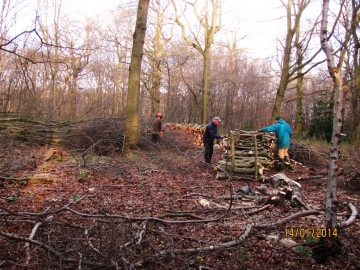
Not everyone agrees though. Some see the felling of even a single oak tree as a sacrilegious act. No amount of discourse about grassland restoration, the loss of nearly all our species rich meadows in the past fifty years, or even a last desperate appeal that they should consult that great oracle of the modern age, Google, does any good. In the end we volunteers leave such pedants to the warden. He seldom has much luck either. The conversation usually ends with an adamant “I don’t care what anyone says, I will never change my mindâ€! On this and much else in their lives I would bet. For ever and ever. Until amen. I know quite a few people like that! Still, I too was unaware the important part played by coppicing in maintaining our woodlands and the wildlife therein until enlightened by Oliver Rackham, so I should not crow too loudly.
Thrift Wood is ancient woodland and may well have had a regular coppicing cycle in the past but unfortunately no one bothered to record it; either that or such records have been lost. Not so Stoneymore Wood, Mill Green. It - along with the Forest springs at Writtle Park and other major woodlands in the area - had probably been coppiced on a regular basis for several centuries before Sir William Petre acquired the estate in the mid-1500s as there are wood sale accounts in the court rolls dating back to at least 1396 (Rackham 2003). However, the practice was not spelled out in detail until a survey of 1781, when it was stated that :
“In the woods…….after the cutting of the Copse Wood, Lord Petre has the right to enclose them for the space of seven years, after which it is thrown open to the tenants of the manor for a further space of ten years, when it is again cut down as Lord Petre’s propertyâ€
The seventeen year coppice cycle implied by the 1781 survey was not strictly adhered to and in practice ranged between eight and nineteen years, with a tendency to lengthen in later decades. For instance, Rackham (2003) states that Great Edney Wood was coppiced in 1691, 1703 and 1711 while surviving wood-books from the late 18th to the late 19th century list Great Stoneymore as being coppiced in 1787, 1800, 1819, 1836, 1850, 1864, 1877 and 1888-89 and Little Stoneymore in 1788, 1800, 1817, 1835, 1848 and 1863. These, of course, were years of major coppicing, when the entire wood was harvested, but smaller transactions would undoubtedly have occurred in other years. An account book of 1800 kept by one William Robertson gives a detailed breakdown of the costs and profits involved. John Clarke & Co was paid £36. 8s 0d for felling 52 acres in Great & Little Stoneymore Woods, at 14s per acre. They also received £77 4s 0d for providing 386 rods of hedging and ditching for use in the same , at 4s per rod, and £8 13s 7d for sundry other items. Solomon Stubbing charged his Lordship £18 8s 6d for 20,000 quicksettes for the new fence around the coppice and William Mullnicks £5. 5s 0d for 500 bush faggotts. William Cocks & Co claimed £2.15s 10d for stopping gaps in the fence separating Deerslade from The Mores (part of Mill Green Common) and for digging post holes in the two Stoneymores while John Otley employed two men for twelve days ditching up gateways in the woods and for this service charged Lord Petre £1. 6s 0d. Finally, John Dawson was paid £1 9s 2d for gate irons and John Bannister 15s for two padlocks In return the Petre Estate received £794 from Messer’s Collins for the coppice wood from Great Stoneymore and £804 from Messer’s Tindel for that in Little Stoneymore. In addition, Henry Finch paid £51 18s 3d for eight loads and twelve yards of bark and Joseph Hills £5 16s 0d for one load and eight yards of oak timber. Thus the income amounted to £1655 14s 3d and the outgoings £125 4s 11d, a profit of £1539 19s 2d. It sounds a lot but, of course, it had been thirteen years since the previous coppice and £1540 divided by 13 = approximately £118 10s per annum. According to Measuring Worth.com, £1 today would have been worth £68.40 in 1800. At school I always viewed mathematics as one of the dark arts but Google makes it easy! According to them, £118.50 x £68. 40 comes out at around £8,105, a relatively modest annual return but a cheque for the equivalent of £105,000 (8,105 x 13) after 13 years would have kept his Lordship in ermine for many a day! (At Thrift the the coppiced firwood makes around £2000 for the Trust each winter and where Sweet Chestnut is involved also yields a good crop of fence posts for use on other reserves).
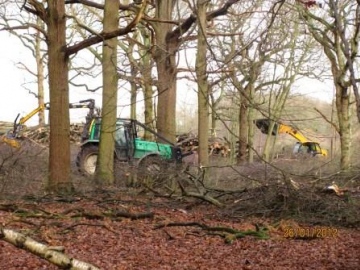 Coppicing modern day style - Deerslade Wood
Coppicing modern day style - Deerslade Wood
The seasonal flow continues, as yet unhindered by any sign of prolonged cold weather. Goat Willow catkins are now bursting with pollen in many a hedgerow and woodland margin and Common Whitlow Grass is in abundant bloom along the seawall at Blue House.
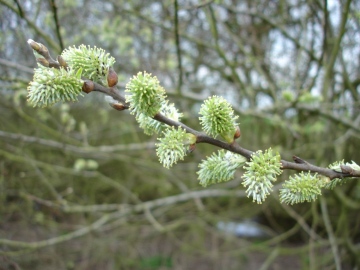
There was a fine male Brimstone on the wing on 22nd at The Backwarden, Danbury and my second Bumblebee species of the year, the Buff-tailed Bombus terrestris, was nectaring at Bergenia flowers in the garden yesterday. Most nights have been too chilly to set the moth trap but there have been a few Common Quakers on the wing and this Hawthorn Shieldbug turned up one evening recently.
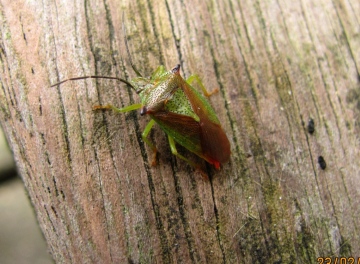
Finally, disaster was narrowly avoided during a work party at Hitchcock’s Meadows EWT Reserve this week as we were about to topple a small dead oak tree in order to clear a fence line. Part of the trunk broke away to reveal this hibernating bat in a small hollow underneath. I’m not sure it is identifiable from the photograph but it was very small and I imagine it to be one of our two species of Pipistrelle. The snapped off section of trunk was carefully replaced and secured with binder twine– so hopefully no harm done - but we proceeded much more cautiously with our task after that!
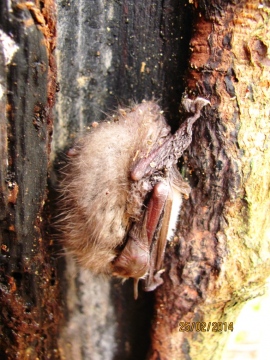
Hares
Thank you, Graham, for two very interesting and very different pieces.
I share your love of Hares, and delight in seeing them in open ground, on the rare occasions when I do see them; actually it is usually only one at a time. I had no idea what huge numbers can be found at night!
When I was a child, about 100 years ago, we lived in Seasalter, next to Whitstable, on the North Kent coast. There were lots of rough grazing fields behind our house (sadly, all gone now, a housing estate has covered all that open land) and only 30mins walk away were Seasalter Marshes, partly cultivated but lots of grazing cattle, and Horse Mushrooms in September. And Hares, both on the old marshes and on the slopes behind our house. We loved to watch them then.
Sometimes we came across a young one, in a 'form' , huddled in a tuft of thick grass. A young one is often parked by its mother, while she gets some food, and the youngster is clearly told not to move out of its hiding place until mum comes back to collect it. We always left it alone.
My mother had, but hardly ever used, the original Mrs Beaton, which had a recipe for jugged hare. It began:
' first, catch your hare....'; we were told you had to see which way it was moving, outrun it (!!!) and sit on it. We never succeeded in that respect, but my mother got one sometimes from the local butcher, who had a friend who went out and shot some at intervals. Then you had to hang it for a week. The stench was dreadful. Then you had to gut it and skin it, and cook it in a casserole in the oven for at least four hours. Wild animals are usually quite tough, so a long slow cook was essential. The stench was terrible during this long cooking, and when the dish was set before us at supper, I and my younger siblings were close to throwing up! I won't continue, lest some of you feel equally nauseated. Eating it was difficult, as the animal was full of lead shot, which you had to spit out. My parents loved it, but the rest of us loathed it! But seeing the live Hares running around was wonderful. More recently, there are some on the landfill site by Ferry Lane, Rainham, and also near Bradwell, where we love the beach and the saltmarsh and the views from the seawall, and the sight of a Hare or two ,usually from the sea wall. Spring is springing
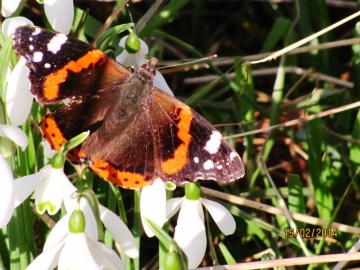
February 19th. A grey morning when I set out to walk to Mill Green Common but a sunny one by the time I arrived half an hour later. Had intended to collect some bryophytes but decided to sit in the sun for ten minutes before starting. Two hours later............... Is there anything more luxurious in life than the first gentle warmth of spring and blessed be to early retirement that I now have the time to wallow in it. The sunshine raised hopes that the first butterfly or two of spring might emerge and these were soon rewarded with a Peacock, sunning itself on a pile of Purple Moor Grass tussocks near where Rob and I had been working. Less expected were two Red Admirals, including this one, which flushed from the bracken and began nectaring at nearby Galanthus flowers. The wing tips were a little faded but otherwise both butterflies were in good condition. There have been some strong southerly winds during recent bouts of stormy weather but the chances are that these two had overwintered. Last year - which was admittedly a very poor one for this species – I did not see my first Red Admiral until August (and only two more thereafter) so to see a couple in mid-February was a delight.
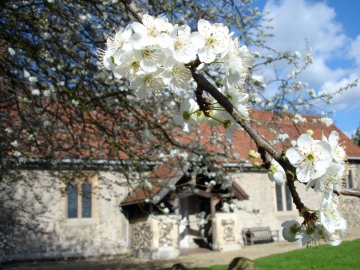
Of course, the spring can still go belly up but it’s a promising start. These Cherry Plum were photographed in Margaretting Churchyard : last year the first blooms did not appear until late March while the Blackthorn did not peak until the first week of May. Three months of wet has got to be better than the three months of unrelenting north-easterlies which we experienced last winter, but then I don’t live on the banks of a river.
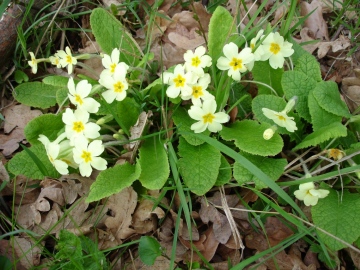
Primroses and Lesser Celandine are also in flower locally and Rob has seen Coltsfoot on the banks of the M25.
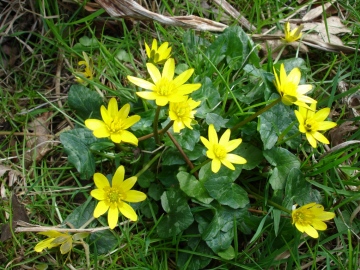
The warmth today also brought forth my first Bumblebee of the spring, the White-tailed Bombus lucorum. Managed to catch one of them as it was suffering from a winter long hangover but it flew off very strongly when released. Sadly, according to the Breakfast News two diseases found in Honey Bees – Deformed Wing Virus and Nosema ceranae – the latter a tiny parasite that was first identified in Asiatic Honey Bees - have now been found in bumblebees as well. Another unwanted import! Stress I reckon; that’s a major player in the recent bee decline. Believe me, you’d be stressed by mid-summer if you were a bee living in this area and your life depended on finding enough pollen and nectar to feed your offspring. Garden and roadside verges would be your best hope; there is precious little else in the wider countryside. Thank goodness for brownfield sites. Hares
February 17th. I visited Ingatestone Hall Farm this morning as I had been told that there are lots of Brown Hares there at the present time. This surprised me, as during the many years I have been walking the parish footpaths I doubt whether I have ever seen more than a couple on a single day. My informant was right, though, as I counted no less than eighteen this morning - dark lumps against the green autumn wheat, with only an occasional twitching ear to give them away. Even allowing for the fact that daydreaming has long been a very bad habit of mine, to encounter eighteen hares in one morning when I had only seen half a dozen during the previous six months bears eloquent testimony to my powers of observation! Mind you, Lord Petre’s gamekeeper at Writtle Park told me recently that if he shot thirty hares on the estate during the course of a winter it would have little effect on their abundance but that if he killed fifty then it probably would, as he estimated the population to be around one hundred and twenty animals, although he was rarely aware of this abundance during daytime walks. Likewise, Nick Robson, who is the EWT’s warden at Bluehouse Farm, North Fambridge, reckons that when they do surveys at night using lamps they often see forty or more hares, whereas you are lucky to see a tenth of that number during a daytime walk. Thus, it is obvious that they are far more nocturnal in their habits than I had imagined.
The late Reg Smith, who farmed with his brother at Jordan’s Farm, Mountnessing, once told me that he thought hares were much more numerous in the past when root crops were grown at Ingatestone Hall and neighbouring farms. They loved to nibble the sugar beet and were considered to be a serious pest. He recalled a cull taking place during the war, during which the workers on the farm surrounded each of the fields in turn and walked slowly towards the centre, the fleeing animals either being shot, clubbed or set upon by dogs. Very few managed to escape and by the end of the day they had killed over two hundred and fifty. They tell me that jugged hare is an acquired taste but whatever their flavour it is unlikely that such a valuable source of protein would have gone to waste in those wartime days.
This story reminded me of a conversation I once had with a visitor to the Bird Observatory at Bradwell. He came from the Saffron Walden area and during a chat about country matters he mentioned that just prior to the last war he had taken part in a day’s shooting during which no less than a thousand Hares were killed. He went on to say that the stench in the barn where the bodies were hung was overpowering! Later in the conversation the subject turned to foxes. Apparently a Vixen had recently broken into his henhouse and killed half a dozen chickens but had taken only one of them. I tried suggesting that if it had been left undisturbed the Fox would probably have returned for the other five and cached them somewhere nearby as a fall-back for a hungry day, but it did no good. He became very animated about it, heaping all manner of abuse on the animal’s head, and concluded by saying that the fox was a bloodthirsty predator which killed things for the sheer pleasure of it. Not like us then………… Mill Green Common
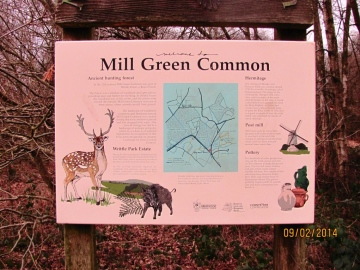 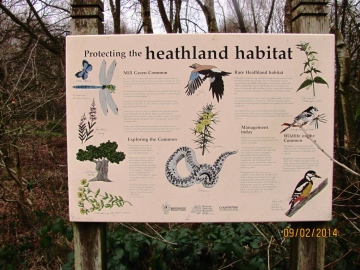
Mill Green Common, the haunt of my youth. Repository of many a happy memory spent playing truant from Ingatestone Secondary Modern. The haunt also of Nightjars and Nightingales, Tree Pipits and Woodlarks - well one at least, which I saw the first time I skipped school and helped ease my guilt considerably - plus dozens of Linnets, bouncy in both flight and character, and Yellowhammers asking for “a little bit of bread but no cheeeeeseâ€. I could hear the cheesy bit it those days but not anymore! Now, fifty years on, the Common is buried beneath secondary woodland and those species, along with so many others, have gone. It was a mixture of heather, gorse and scrubby woodland in those days but earlier in its history it had been wood pasture. There is a record from the late 18th century of 800 trees being “falled†on the Common, either pollarded or, as the word suggests, felled, as pollarding was going out of fashion by that time. I always found it hard to equate 800 of the thick trunked, top heavy pollards often seen in hedgerows nowadays with the little old common that I knew – there would have been no room to breathe!
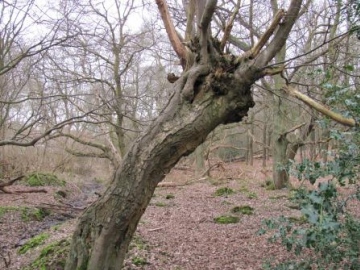
But Mark Hanson informs me that there are records from Epping of up to 1000 pollards per acre and this Hornbeam, one of the few survivors at Mill Green, indicates the much smaller, more manageable size they would have been in those days. After pollarding ceased and the trees were removed the Common reverted to heathland, a working environment where clay was dug, commoner’s animals were grazed and scrub, gorse, bracken and heather were harvested, the last named so abundant that it was sent to the London markets. It was the last knockings of this way of life that I experienced as a boy.
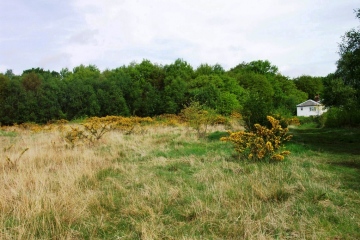
Only one small patch of the old Common remains, a couple of acres of gorse, heather and grass opposite The Cricketers, flanked on one side by the ancient track known as Maple Tree Lane and on the others by Mill Green Park and the road that currently bisects the Common. Until recently this small area too was in danger of being submerged by woodland but during the past few winters Rob Smith, the County butterfly recorder, and myself have been working – with Lord Petre’s permission - to preserve at least a little of the biodiversity that once flourished here. We have cut down dozens of birch trees - many up to 20` tall – and several of the scrub oaks and created a couple of clearings among the gorse where heather is already beginning to reappear. We are currently trying to thin out the dense tussocks of Purple Moor Grass that are swamping the heather in damper corners of the site. Rob has already broken a pickaxe and a mattock while engaged in this task so is obviously working a lot harder than I am! Not that I have anything against Purple Moor Grass – it provides winter shelter for a wide variety of creatures, including Lizards, and twice in the past I have found Dormice nests buried in the tussocks. Gorse too is a valuable habitat for a large number of invertebrates and decent stands of it are surprisingly scarce in Essex. So if we manage to maintain a mosaic of mini-habitats such as these we will be well pleased. As well as heather other plants have also begun to return to the cleared areas, Green-ribbed, Oval and Pill Sedges among them, an emerging flora that also includes two species well outside their normal range – Sweet Briar and Wild Basil – the seeds perhaps brought into the area on the feet of deer or ramblers. Or possibly would-be conservationists! We look on it as our “patch†and have had plenty of interesting finds there. Rob photographed these two Essex Red Data Book micro moths, Epichnopterix plumella and Grapholita internana, last summer and Mark found this scarce woodland hoverfly, Brachypalpoides lentus, nectaring on bramble where Common and Stoneymore Wood meet. G. internana is a gorse feeder while E plumella - which is largely confined to the coast in Essex – is active in the spring sunshine. There have been lots of commoner species too of course, all of which have been great fun to find and identify.
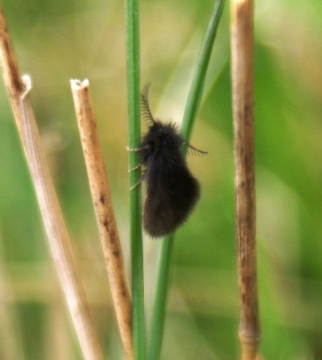
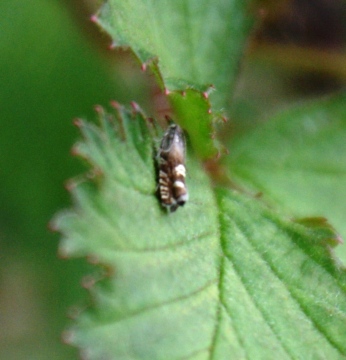
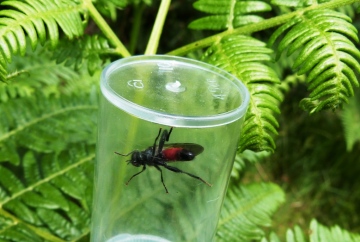
In the grassy areas away from the gorse one patch stands out from all the rest. It is 22 yards long and the coarse rank vegetation that covers it contrasts markedly with the shorter Red/Sheep’s Fescue grassland surrounding it. Back in the 1980s some bright spark had the idea of creating (or possibly re-creating) a cricket pitch on the Common. They probably had visions of relaxing outside The Cricketers, glass of brandy in hand, listening to the thump of leather against willow and shouting “Bravo – well played that man†and similar cries of encouragement. It survived for a year or two until rushes began popping up in the popping crease but what really scuppered it was the discovery of a stash of hand grenades when they attempted to extend the outfield. The Common had been used as an army training ground in the First World War. Hard to believe when you see it now but I suppose that the old clay pits bear a passing resemblance to shell craters and in a winter such as this one there would have been plenty of mud. Nothing though could have prepared them for what was to come and I wonder how many of those that trained there survived the horrors of the trenches. For me it has happier memories as the setting for childhood games between cowboys and Indians; a childhood that began as General Custer but ended up very firmly on the side of Crazy Horse! Clever, or what?
A clever animal - a very clever one - invents a chainsaw, the quicker to cut down the forests with. An intelligent one learns to use the chainsaw wisely and harvest the forest sustainably. So what are we - clever or intelligent, or is the issue still in the balance? And do we mistake the one for the other? Spring around the corner? You must be joking!
When the waters subside, we might get some spring, but not yet!
I feel for those sheep, getting their legs and trousers wet at Blue House Farm. Sheep have been put out on reclaimed marshland for centuries, and when it gets very wet the sheep hate it, but the cows don't seem so worried. In 1953 I lived on the north Kent coast, with Seasalter marshes and Graveney marshes very close by. When the sea came in at night, some of the animals could reach higher ground, as these reclaimed marshes had odd humps that the local people thought were tumuli (old burial places) until one was found with a Viking longboat in it! Anyway, animals that could reach these, stood on them, and they were all rescued within a couple of days, with no harm done. But there were large high fences separating different groups of animals, and animals so enclosed all drowned, as there was no higher ground within the fences. The water was over 2 metres deep, higher than the now just-submerged fences, and it stayed like that for months. I was told that the bodies were near the fences, mostly, so they had clearly swum to get away, but were foiled as they tried to cross the barbed wire fences.
So I feel for those sheep on the marshes at Blue House Farm. Most herbivores are pretty stupid, as you don't have to be clever to eat green plants, but you have to be clever enough to foil a predator, mostly by running away. But, I am told, that sheep in Wales have learned to stand by a gate, another sheep climbs on its back and can then hop over the gate. Most of that flock will follow, leaving the poor first one behind, away from its friends! They are clearly not all as stupid as we might suppose, apart from the one that stands by the gate, as he/she is trapped inside! Sheep
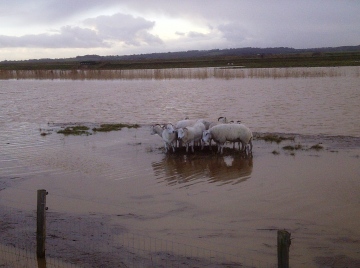
It is a little known fact that sheep do not like to get their feet wet. They can swim perfectly well but when stranded on small islands of higher ground amid floodwater – like the Wiltshire Longhorns pictured here at Blue House Farm EWT Reserve recently – they prefer to wait patiently for the water to subside rather than attempt to brave the flood. This is an admirable trait compared with the behaviour of many motorists. A much maligned animal is the sheep. The contempt we have for them springs from their flocking behaviour and the instinctive desire of the more submissive animals to follow the dominant members of the group. In Turkey recently the leader of a flock attempted to leap a fifteen foot wide ravine - and all 399 of his followers followed suit, with unfortunate results. Following a Great Leader to perdition is unknown among us humans of course, hence the contempt…………
If you want to exploit an animal without worrying too much about it, it probably helps if you look on it as being stupid but recent research has shown them to be anything but. In Yorkshire, sheep have been observed lying on their sides and rolling over and over in order to cross three metre wide ‘hoof-proof’ cattle grids. The lure in this instance was the cabbages and lettuce in village gardens as sheep, given the choice, prefer a varied diet rather than boring old grass. Research in Australia has revealed that sick sheep may actually be able to detect what nutrients they are deficient in and actively seek out plants that make them feel better, having developed a knowledge of which species are beneficial and which toxic. Perhaps that is what those Yorkshire sheep were up to! Researchers have also found that a sheep can recognize the faces of over fifty other sheep and familiar human faces as well; indeed, it is thought that they may be as good at picking out faces in a crowd as we are. They also form family and social friendships within a flock and ewes have definite opinions about what makes a ram’s face attractive!
As for Icelandic sheep, they are a class apart, as I can vouch for myself. I was once savagely assaulted by an Icelandic ewe when I got between her and her lamb. The incident happened close to Lake Myvatn, in the north of the country. I had stopped on the road to watch a Gyr Falcon and was standing astride my bike when the ewe in question came charging up the gravel embankment and head butted me with such force that I was catapaulted down the other side, landing in a grazed and bloodied heap at the bottom. The humiliation of it – done over by a sheep! But now what do I find? There is a strain of sheep in Iceland known as Leadership. Leadership sheep are highly intelligent and have an exceptional ability to sense danger. Apparently there are numerous stories in Iceland of Leadership sheep saving many lives during the autumn roundups when blizzards endangered shepherds and sheep alike. There you are. I don’t feel so bad about it now. In fact it almost feels like an honour – to have been beaten up by a Leadership sheep. Mind you, having read Rider Haggard’s adaptation of the Icelandic sagas as a youth it should not surprise me that Eric Blood Axe and his compatriots’ sheep are chips off the same block! (Thank you www.followyourdreamfarm.net/sheepbehaviour for enlightening me).
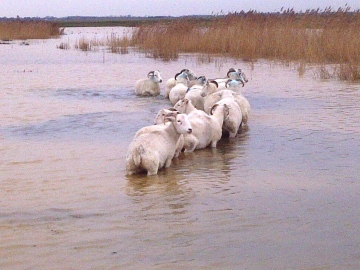
Anyway, something to think about when sitting down to your next lamb chop. I’m a vegetarian by the way. Thought I’d mention it! The Longhorns were eventually led to safety by the reserve warden Nick Robson and it was he who took the photographs. Fortunately, although the reserve may look flat that is not strictly the case. Even the so called ‘Flat Fields’, which were the first to be reclaimed from the saltings (probably around 1700), don’t seem that way when you are bouncing up and down in the Land Rover as it crosses the old ridge and furrow plough lines. Most of the other fields, which were reclaimed later, were never so intensively cultivated and still retain traces of the old creek system and are full of bumps and dips and redundant grassed over anthills. Thus there is always somewhere for the sheep to retreat to at times like this. Not that there has been any previous time quite like this one since the Trust took over in 1998. As the Met Men keep telling us, this winter has been exceptional. At Blue House though, unlike the Somerset flood plain, the water soon subsides again : the bridge leading to the New Hide may be two feet underwater one day but is often usable the next. Even so, there has been no need to turn on the wind pump this winter to flood Round Marsh (below), which the hide overlooks; the rain has managed that all on its own.
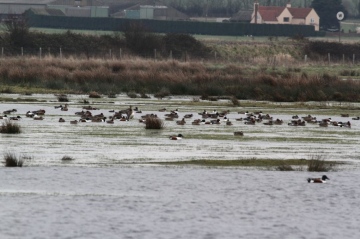
If your fields or your sitting-room are knee deep in water you may not appreciate it but this winter has probably been better for most wildlife than the three months of unrelenting Russian winds that bedevilled us this time last year.
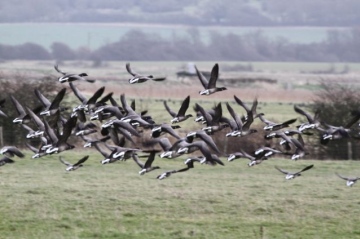 Brent Geese in flight - John Lilley
Brent Geese in flight - John Lilley
Despite the rain it has been a sunnier winter than most and often a joy to be out and about. Even on the dullest January day though birds can provide the life, light, colour and movement that the mind craves at this time of year (or at least this mind does) and there are plenty of those on the farm at the moment – noisy flocks of ground stabbing Rooks and Starlings seeking out leatherjackets, the progeny of last autumn’s bumper crop of Daddy Longlegs; thousands of Peewits, flickering black and white against the blue sky, their crops full of worms forced close to the surface by the constant rain; Curlews plodding methodically across the mudflats, probing deep for lugworms; Brent Geese – their ranks swelled with youngsters after a successful breeding season last year on the Tamyr Peninsular – working their way slowly across the meadows, clipping the grass as short as a garden lawn; and ducks, plenty of ducks. It’s been great weather for ducks!
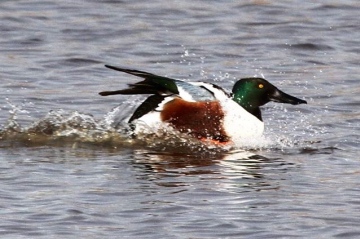 Drake Shoveler - John Lilley
Drake Shoveler - John Lilley
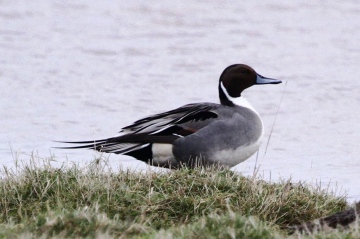 Drake Pintail - John again!
Drake Pintail - John again!
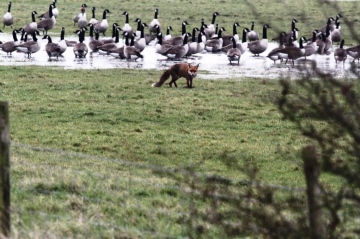
Vulpes the Fox. He is probably being a little bit ambitious if he has his eye on the Canada Geese behind him - fat and fluffy goslings are more within his range. Thanks again to John for allowing me to use his photo.
Nevertheless, the desire to see things growing again; to plant seedlings in pots and sow seeds in rills; to work in the garden without hands becoming coated in thick cold mud, and to wallow in early spring warmth while watching the wildlife – slugs, snails, greenfly – return to my little plot becomes overwhelming as January drags into February. Spring can’t come soon enough. Apologies
Mary - thank you for your kind words but I'm not sure whether this forum is the right place for these pieces or not. But it has long saddened me to see it so little used. Much of what I do on a computer is pure drudge so its nice to refresh the mind with something a little more creative and to express a personal view on natural history. Sometimes I feel I belong more to the old style Field Club than the new. There is something appealing, is their not, in the way they used to do it - taking a carriage to the day's venue from the nearest railway station; a leisurely stroll in the countryside or around some ancient monument or house; a midday break, either to the nearest pub (sorry, hostelry) or to a "Gentleman's" house, where they were wined and dined by the owner; then a further stroll followed by "afternoon tea" - outside if the weather allowed; and finally a carriage back to the Station and a return home in the evening twilight. Of course, had I been alive in those days I would have been the one lugging the supplies on my back and serving the tea and crumpets, not sharing the day out, so it's not a bygone age I long for. When it comes to this country I reckon I have, at the age of 66, been part of the luckiest generation ever born. Still, there is something to be said for a more leisurely approach to life than the current one, as long as the majority of the population can enjoy it. And while we are in the business of extending praise, may I say that although I always read the Essex Naturalist from cover to cover I always head for your articles first. Your "Tales from the Archives" are a thoroughly enjoyable read, content and style alike!
Anyway (above) .................. |
|
Archives:
May 2020
Aug 2019
Jan 2019
Sep 2018
Jul 2016
Oct 2015
Jul 2015
May 2015
Apr 2015
Mar 2015
Feb 2015
Jan 2015
Dec 2014
Oct 2014
Sep 2014
Aug 2014
Jul 2014
May 2014
Apr 2014
Mar 2014
Feb 2014
Jan 2014
Dec 2013
Nov 2013
Sep 2013
Aug 2013
Jul 2013
Jun 2013
May 2013
Apr 2013
Mar 2013
Feb 2013
Jan 2013
Dec 2012
Nov 2012
Oct 2012
Sep 2012
Aug 2012
Jul 2012
Jun 2012
May 2012
Apr 2012
Mar 2012
Feb 2012
Jan 2012
Dec 2011
Nov 2011
Oct 2011
Sep 2011
Aug 2011
Jul 2011
Jun 2011
May 2011
Apr 2011
Mar 2011
Feb 2011
Jan 2011
Dec 2010
Nov 2010
Oct 2010
Sep 2010
Aug 2010
Jul 2010
Jun 2010
May 2010
Apr 2010
Mar 2010
Feb 2010
Nov 2009
Oct 2009
Aug 2009
Jul 2009
Jun 2009
May 2009
Apr 2009
Mar 2009
Feb 2009
Jan 2009
Nov 2008
Oct 2008
Sep 2008
Aug 2008
Jul 2008
Jun 2008
May 2008
Apr 2008
Mar 2008
Feb 2008
Jan 2008
Dec 2007
Nov 2007
current posts
|
 Coppicing modern day style - Deerslade Wood
Coppicing modern day style - Deerslade Wood







































